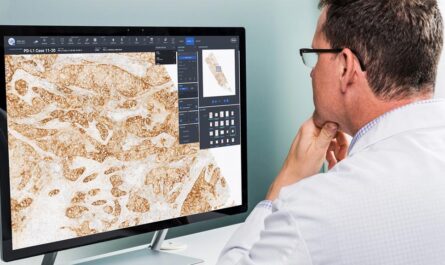Digital technologies have enabled vast amounts of personal health data to be collected through everyday devices like smartphones, wearables and connected home devices. This data holds tremendous potential for developing digital biomarkers – measurable digital phenotypes that can provide meaningful insights into an individual’s health status and serve as outcome measures in clinical studies.
What are Digital Biomarkers?
A digital biomarker refers to an objectively quantified metric derived from digital sources about normal biological and pathogenic processes that can be used for diagnostic or prognostic purposes or to assess risk, monitor progression or determine therapeutic responses. Some examples of digital biomarkers include:
– Mobile Sensing Biomarkers: Metrics derived from built-in sensors in consumer devices like step count, heart rate, sleep patterns etc. that can provide clues about physical activity levels, sleep quality or signs of stress.
– Surveys and Assessments: Self-reported metrics from digital surveys and questionnaires administered through apps and web portals covering symptoms, medication adherence, quality of life etc.
– Online Behavioral Markers: Digital footprints derived from online interactions like website browsing, search queries, social media engagement that could reveal cognitive decline or changes in mood.
– Physiological Biomarkers: Metrics inferred through analysis of vocal, breathing or facial patterns picked up by device microphones and cameras with potential links to neurological or cardiovascular conditions.
Deriving Meaningful Insights
The raw digital data from these diverse sources need sophisticated analytics to distill meaningful insights. Techniques like machine learning, natural language processing and predictive modeling are increasingly being used to:
– Establish Normative Ranges: Analyzing large, longitudinal datasets helps determine normal vs abnormal ranges for a given digital biomarker across demographics.
– Detect Abnormal Patterns: Algorithms can detect subtle deviations and changes over time in digital biomarkers that may indicate progression or worsening of disease.
– Predict Future Outcomes: Predictive models use past digital biomarker trends to forecast clinical events, hospitalizations or response to therapy with reasonable accuracy.
– Correlate with Established Endpoints: Associating digital biomarkers to established clinical measures helps validate their clinical relevance and usefulness.
When combined with traditional medical assessments, digital biomarkers hold promise to provide an uninterrupted, multidimensional view of health status for timely clinical decision making.
Applications in Chronic Disease Management
Digital Biomarkers have useful applications across chronic conditions with some leading examples discussed below:
Cardiovascular Disease Management
Utilizing photoplethysmography (PPG) signals from smartwatches, researchers have developed algorithms that can derive metrics like heart rate variability (HRV), pulse transit time (PTT) with links to heart failure exacerbations and hypertension control. When combined with mobility and activity data, digital biomarkers allow remote monitoring of patients at risk of cardiac events.
Diabetes Management
Continuous glucose monitor (CGM) readings paired with insulin dose records, meal photographs and exercise logs enable deriving predictive digital biomarkers for hypoglycemia risk, insulin sensitivity changes and diet/activity impacts on blood sugar levels. This allows for personalized, just-in-time interventions.
Mental Health Monitoring
Digital surveys, voice analyses, keyboard/typing dynamics and social media interactions are poised to uncover digital biomarkers predictive of depression relapses, manic episodes in bipolar disorder or cognitive changes in dementia when remotely tracked over time.
Respiratory Disease Tracking
Listenings to patients’ breathing from their smartphones can help detect exacerbations early and derive metrics like cough frequency correlated to lung function decline in chronic obstructive pulmonary disease (COPD). When combined with medication and symptom tracking, this enables proactive care.
Advancing Precision Medicine
Perhaps the biggest promise of digital biomarkers lies in advancing precision or personalized medicine through large real-world evidence generation. Aggregating diverse health data from thousands to millions of individuals over the cloud allows:
– Phenotype Stratification: Grouping individuals into distinct subgroups based on their longitudinal digital biomarker profiles to better understand heterogeneous disease trajectories.
– Therapy Response Prediction: Using past response patterns to predict each individual’s likelihood of responding favorably or adversely to a given treatment regimen, dosage or regimen changes.
– Drug Development: Powering clinical trials with real-world efficacy and safety tracking through digital biomarkers for faster drug approval pathway.
– Polygenic Risk Scoring: Refining predictive risk models to more accurately stratify individuals by combining genetic risk scores with environmental and lifestyle digital biomarkers.
In summary, digital biomarkers extracted from ubiquitous consumer-facing devices present an unprecedented opportunity to objectively monitor health outside clinical settings in everyday life. When combined with conventional medical data, they hold potential to foster major advances in proactive, personalized chronic disease management, therapeutics development and implementation of precision medicine at population scale in the coming years. Appropriate regulatory reviews and privacy safeguards will certainly be needed to responsibly translate this promise into real world impact.
*Note:
1. Source: Coherent Market Insights, Public sources, Desk research
2. We have leveraged AI tools to mine information and compile it


